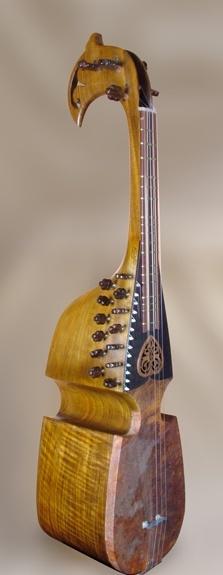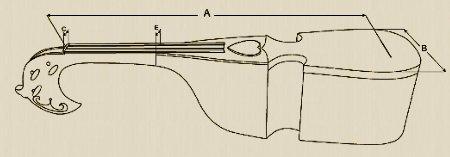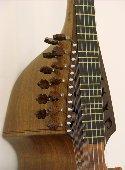
The word rebab (robab) is an Arabic term that can be translated as bowed string instrument. Dating back at least to the 8th century, the Rebab has been closely associated with Islamic culture and is thought to be the earliest ancestor of the contemporary violin.
While its roots are in Persia, the rebab's influence has reached as far east as Indonesia and west to regions of Europe and Africa. Its diffusion is closely tied to the growth of the Islamic world and the development of extensive trade routes after the 10th century.
As part of the generic 'lute' family, there are two basic types of rebab: wooden fiddles with pear-shaped or elongated bodies, and spiked fiddles, named for the extension or spike on the bottom of the instrument on which it stands when played. Generally, both styles have 2 or 3 gut or other strings.
Spike-fiddle rebabs used in the Javanese gamelan are made from wood, or sometimes from a hollowed, half coconut shell covered with hide. This body is attached to a long, narrow wooden neck which has no frets; instead, the fingers of your left hand become moveable bridges. These instruments ornament the melodic line, creating a dialogue with the singers.
Rabab is an stringed instrument which is mostly played in Sistanbalouchestan region Iran.
Nowadays Rabab has got a special place in traditional Persian music because of its wide range of producing bass sounds, for this there is a sound hole created between the neck and the soundboard as you see in the picture.
This instrument have two tuning peg boxes:
1. Tuning box on the headstock
2. Tuning box on the body
Sound range of Rabab is two octaves

Parts of Rabab are:
1. Body (walnut or mulberry wood)
2. Neck and headstock (walnut wood)
3. Bridge and nut (Ibex horn)
4. Soundboard (goat skin)
5. Tuning pegs (walnut wood)
Rabab are also built in different sizes:
1. Soprano
2. Alto
3. Bass (Jumbo)

Sizes By Millimetre
A B C D
Rabab soprano 625 170 38 35
Rabab alto 660 180 39 36
Rabab jumbo 740 205 40 37
Ordering options:

1. The body tuning pegs in Alt version can be ordered from 7 to 13 and in Jumbo from 8 to 15 pegs
2. Merhkari (inlay on wood decoration): is possible on the fingerboard and also on the both side of the body
3. The numbers of Main-strings
A: 3 single bass strings plus 3 single treble and/or
B: 3 sets of double stings instead of separate
4. The length of the finger board:
A: Short finger board 18 frets
B: Long finger board 27 frets
Included:
1. One set of strings
2. Pick
3. Handmade hardcase